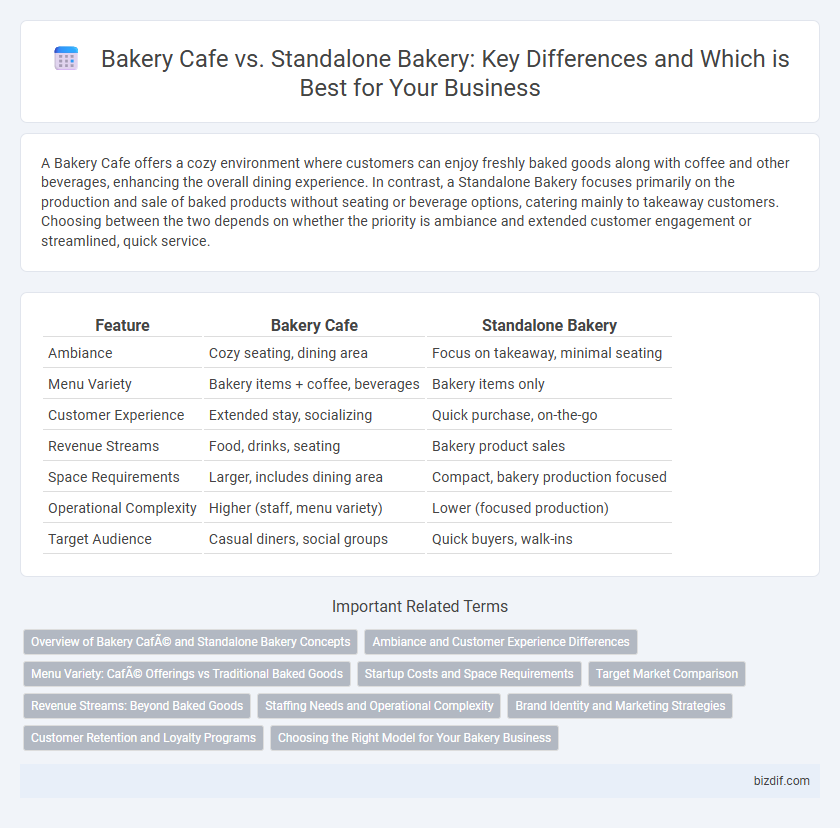A Bakery Cafe offers a cozy environment where customers can enjoy freshly baked goods along with coffee and other beverages, enhancing the overall dining experience. In contrast, a Standalone Bakery focuses primarily on the production and sale of baked products without seating or beverage options, catering mainly to takeaway customers. Choosing between the two depends on whether the priority is ambiance and extended customer engagement or streamlined, quick service.
Table of Comparison
| Feature | Bakery Cafe | Standalone Bakery |
|---|---|---|
| Ambiance | Cozy seating, dining area | Focus on takeaway, minimal seating |
| Menu Variety | Bakery items + coffee, beverages | Bakery items only |
| Customer Experience | Extended stay, socializing | Quick purchase, on-the-go |
| Revenue Streams | Food, drinks, seating | Bakery product sales |
| Space Requirements | Larger, includes dining area | Compact, bakery production focused |
| Operational Complexity | Higher (staff, menu variety) | Lower (focused production) |
| Target Audience | Casual diners, social groups | Quick buyers, walk-ins |
Overview of Bakery Café and Standalone Bakery Concepts
A Bakery Cafe combines fresh-baked goods with a full-service coffee bar, offering customers a place to sit and enjoy pastries alongside specialty beverages, creating an inviting social atmosphere. Standalone Bakeries focus primarily on producing and selling baked products such as bread, cakes, and pastries, often emphasizing artisanal quality and take-home convenience without on-site seating. The Bakery Cafe model appeals to consumers seeking a dine-in experience, while Standalone Bakeries cater to customers prioritizing quick pickup and product variety.
Ambiance and Customer Experience Differences
A bakery cafe offers a relaxed ambiance with comfortable seating, music, and decor that invites customers to linger and enjoy freshly baked goods alongside coffee or tea, creating a social and leisurely experience. In contrast, a standalone bakery prioritizes efficient service and quick transactions, focusing on the quality and variety of baked products rather than extended customer stays. The customer experience in a bakery cafe emphasizes atmosphere and comfort, while a standalone bakery highlights convenience and speedy product accessibility.
Menu Variety: Café Offerings vs Traditional Baked Goods
Bakery cafes typically offer a diverse menu that includes coffee, specialty beverages, and light meals alongside traditional baked goods, appealing to customers seeking a full cafe experience. Standalone bakeries focus primarily on a wide range of freshly baked items like bread, pastries, and desserts, emphasizing artisanal quality and variety within bakery products. The expanded menu in bakery cafes enhances customer engagement by providing a relaxed environment for both dining and takeaway options.
Startup Costs and Space Requirements
A bakery cafe requires higher startup costs due to the need for seating arrangements, decor, and additional kitchen equipment to support on-site food preparation and service, whereas a standalone bakery primarily focuses on production equipment and countertop display cases. Space requirements for a bakery cafe are significantly larger, often needing at least 1,200 to 2,000 square feet to accommodate both kitchen operations and customer seating, compared to a standalone bakery's 800 to 1,200 square feet primarily dedicated to baking and retail display. Efficient space planning in a bakery cafe integrates customer flow and comfort, driving up initial investment and operational complexity.
Target Market Comparison
Bakery cafes attract a diverse audience including casual diners, remote workers, and social meetups seeking a comfortable ambiance alongside quality baked goods. Standalone bakeries primarily target customers focused on quick purchases, often appealing to local residents and passersby looking for fresh bread or pastries. The cafe model caters to longer visits and premium experiences, while standalone bakeries emphasize efficiency and product variety for immediate consumption.
Revenue Streams: Beyond Baked Goods
Bakery cafes diversify revenue streams by combining baked goods with beverage sales, such as coffee, tea, and specialty drinks, increasing average customer spend and encouraging longer visits. Standalone bakeries primarily rely on direct sales of pastries, bread, and cakes, limiting revenue potential but benefiting from lower overhead costs. Incorporating seating and specialty drink menus in bakery cafes creates multiple income sources, enhancing profitability beyond traditional baked goods sales.
Staffing Needs and Operational Complexity
A Bakery Cafe requires a diverse staff skilled in both baking and customer service, increasing operational complexity due to menu variety and seating management. In contrast, a Standalone Bakery primarily focuses on production staff with streamlined operations centered on baking and packaging. Staffing efficiency is higher in standalone bakeries, while bakery cafes demand a balance between kitchen and front-of-house personnel to ensure smooth service and product quality.
Brand Identity and Marketing Strategies
A Bakery Cafe combines the appeal of fresh baked goods with a comfortable dining experience, enhancing brand identity through ambiance and customer engagement, while a Standalone Bakery primarily focuses on product quality and specialty offerings to build recognition. Marketing strategies for Bakery Cafes emphasize social media promotions showcasing the cafe atmosphere and menu variety, whereas Standalone Bakeries leverage local partnerships and loyalty programs highlighting artisan craftsmanship. Both models rely on consistent branding, but Bakery Cafes create a lifestyle connection, and Standalone Bakeries emphasize product authenticity.
Customer Retention and Loyalty Programs
Bakery cafes enhance customer retention by combining fresh baked goods with a comfortable environment, encouraging longer visits and repeat business through loyalty programs offering discounts and personalized rewards. Standalone bakeries rely heavily on product quality and unique recipes to build loyalty, often implementing punch cards or app-based rewards to incentivize frequent purchases. Integrating digital loyalty programs in both formats significantly boosts engagement and fosters a dedicated customer base.
Choosing the Right Model for Your Bakery Business
Selecting the right model between a bakery cafe and a standalone bakery depends on your target market and operational goals. A bakery cafe combines fresh-baked goods with on-site seating and beverage service, attracting customers seeking a social and dine-in experience, which can increase average transaction value and customer retention. In contrast, a standalone bakery focuses primarily on takeaway and wholesale orders, emphasizing production efficiency and lower overhead costs ideal for high-volume sales or niche artisanal products.
Bakery Café vs Standalone Bakery Infographic

 bizdif.com
bizdif.com